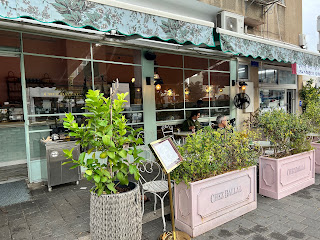The Desert, Masada and the Dead Sea
After yesterday's legwork, I was looking forward to a little less time on stone steps and steep hills... which makes no sense when you think about going to the desert and Masada. As my guide
Elana and I left Jerusalem (and it's a significant car ride) the city traffic and dense development quickly gave way to the desert. One minute you are near cars and irrigated land and the next, it was barren, dry and mountainous.
Although I'd read up on the tectonic plates that separated and created the Dead Sea at 430 meters below sea level (its shores are the lowest spot on earth!), I wasn't prepared for how large it is and how little development there is in the desert. It was endlessly breathtakingly beautiful, even with haze that obscured the view of the far shore in Jordan. It wasn't hard to see how far the Dead Sea has receded, exposing what used to be under water and now is pocked with sinkholes and whitened by mineral deposits along the narrowing shore. The Dead Sea minerals are big business and I'm not sure I understand conservation efforts being made to protect the ecosystem.
There are a few spots on the way to Masada where there are springs, most notably the oasis Ein Gedi, which is the largest oasis in Israel, with 4 natural springs. And ibexes in trees, in herds, and crossing the road.
Masada was every bit as dramatic and mysterious as I'd been led to expect. My guide Elana brought Flavius Josephus's history and while in the rooms of Herod's palace, she read the passages where he described, in his contemporaneous account, what transpired when a holdout group of rebel Jews were surrounded by Roman armies. The story Josephus tells of what happened there has a can't-be-coincidence turn of events that mirrors what happened to Josephus himself when trapped in a cave with other soldiers under attack by Romans in 67 AD -- the drawing of lots to determine the order of killing themselves rather than being taken alive as prisoners by the conquering army. In Josephus's case, he was the last one alive and lived on to become a writer and to tell his own story and many others, including the legend of Masada. The excavation of King Herod's palace, which was in place but abandoned when the rebels took refuge there, does provide many confirming details of the story of Masada... but not all and certainly not the story of a choice to die rather than be taken by the opposing army.
After we left Masada, I revisted my stated intention to see, but not swim, in the Dead Sea. Here I was, halfway around the world, where people built a stone city on a mountain top and I didn't want to swim? I, who conquered the Boiling River in Yellowstone (with the help of my friends!) three years ago? It wasn't hard to find a bathing suit for sale at the Ein Gedi oasis ... so we headed to the Dead Sea Kalia Beach. It's a scene -- many people floating in the water, coating themselves head to toe with healing mud and a mix of very few "beautiful people" and a lot of older people looking for a cure for whatever ails them. Maybe all the beachgoers from earlier in the day were livelier and hanging out at the bar ("the lowest bar on earth!").
But I went in and I floated. No, you will not see pictures.
The water feels oily and the salt deposits are rough and crusty when you encounter them. You emerge from the water feeling -- in contrast to the moments of ethereal floating -- like you are made of the earth and covered in the earth. I kept it pretty brief and was glad to shower.
At Kalia Beach, there's a striking art "gallery" of work painted on abandoned buildings that were last occupied when Jordan ruled the beach. Gallery -430 was a 2018 project that brought graffiti artists from around the world to take a stand for protection of the Dead Sea and to promote unity among the factions who need to work together for conservation. Their works were powerful and moving. Although I have tried to identify the individual artists online, there's a list of them but not correlated with the work they've done at the site.










Comments
Post a Comment